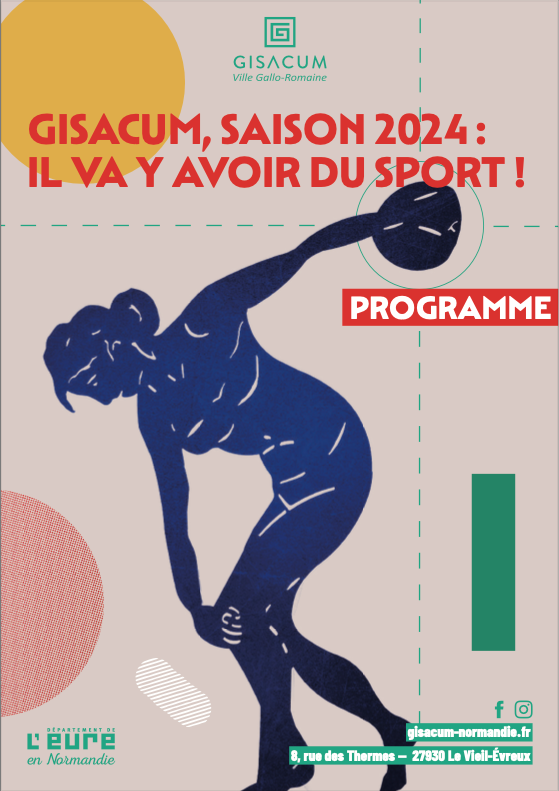Gisacum – a natural site
The 2.5 hectares of baths and archaeological gardens account for only 18 percent of the land owned by the Département on the Gisacum site. The other plots are grasslands beneath which a number of ancient monuments are buried.
All of this property constitutes an ordinary natural area with a variety of plant and animal wildlife. For both environmental and economic reasons, the management and upkeep of these areas has been entrusted to the Conservatoire d’Espaces Naturels de Haute-Normandie (Upper Normandy Natural Space Conservatory), an association that works to protect the natural heritage of Upper Normandy.
Work on the site of Old Evreux
Since 2002, the Conservatoire d’Espaces Naturels de Haute-Normandie (CEN HN) has been caring for the Gisacum’s archaeological heritage by installing sheep grazing land, thus maintaining this natural space in an environmentally-friendly manner.
In 2007 and 2008, the Eure Département asked CEN HN to conduct an ecological diagnosis of the site. This resulted in a report on the condition of the plots of land with respect to natural habitats for plant and animal species. These inventories have allowed a management plan to be drafted that combines the preservation of the archaeological heritage and the promotion of greater biodiversity.
Management measures implemented on the site:
Conservatoire d’Espaces Naturels de Haute-Normandie
 The Conservatoire d’Espaces Naturels de Haute-Normandie is an association for the protection of the environment approved by the Ministry for the Ecology, Sustainable Development and Energy and as a youth and popular education association. There are four major aspects of the Conservatory’s work to preserve the natural heritage of our territory:
The Conservatoire d’Espaces Naturels de Haute-Normandie is an association for the protection of the environment approved by the Ministry for the Ecology, Sustainable Development and Energy and as a youth and popular education association. There are four major aspects of the Conservatory’s work to preserve the natural heritage of our territory:
- Knowledge and understanding of how natural environments function, with research and scientific inventories
- Protection of natural sites of outstanding heritage value by controlling land use
- Management of environments through restoration and maintenance to preserve biodiversity
- Enhancement of sites and awareness-raising for the general public.
For further details: www.cren-haute-normandie.com
Results of the ecological diagnosis
Located on an agricultural plateau comprising field crops, the Old Evreux site is a natural beauty spot that should be preserved:
- 215 plants, of which 11 are remarkable in Upper Normandy
- 12 butterfly species and 8 cricket/grasshopper species
- 11 dragonfly species and 3 newt species in the site’s only pond
- 40 birds observed on the site, including 27 nesting birds
Extensive grazing
The herd grazing on the Old Evreux site consists of Solognote sheep. This is a historic breed that takes its name from Sologne – a region for which it was very suitable and where, from the fifteenth century onwards, it contributed to the wealth of the peasants.
Solognotes are very hardy both in terms of their disease tolerance and their ability to make the most of poor, woody vegetation. The breed has an amazing capacity to adapt to the most unstable conditions and to recover.
Extensive grazing allows the grasslands to be maintained whilst favouring greater diversity in terms of vegetation and species. The sheep also play an important role in transporting seeds: these may be carried along in their wool or pass through their gut.
Late mowing
Mowing allows the grasslands to be maintained. When performed later than mid-July, it allows vegetation to develop, producing seeds before the machinery is used.
The hay is harvested to avoid enriching the soil, so that weeds do not grow. It is also used in winter to feed the herd of sheep on the site all year round.
Preservation of refuge zones
Some areas used neither as pasture nor for mowing are kept as refuge areas for plant and animal wildlife. These are used for reserve plants for seeds, and also play a major role for insects in particular, providing them with food and a place to hide from predators – as well offering shelter in the winter.
Combating invasive alien species
Once introduced into natural environments, alien species can proliferate and take the place of native flora and fauna.
American crayfish and Florida turtles are fearsome carnivores in ponds. They can wipe out populations of insects and amphibians in just a few years.
On the site of Old Evreux, Japanese knotweed – a plant pest – is grazed several times a year to contain the population. The Black Locust tree, native to North America, was cut down a number of years ago on the site, but shoots still need to be cut back every year.
Experimental growing to encourage meadow flowers (grainland plants)
Grainland plants like to grow amid crops. They are often annual plants, whose cycle is similar to that of cereals. Most of them are retreating due to the intensification of crop practices, the use of denser sowing, and more competitive varieties.
The Eure Conseil Général has drawn up an Action Plan to save these wild flowers (around one quarter of the species found in the département have disappeared in recent decades). The Conservatory is conducting experimental action on certain sites, including Gisacum.



















